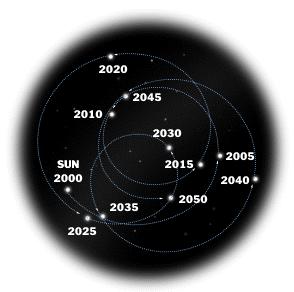Einstein conceptually falsely assumed in his Theory of Relativity that solar systems rotate around the central body of a solar/star system and that the curvature of the space-time continuum effected by the mass of the central body keeps the planets in a solar system (or satellites around the earth) on their path around the central body (or in the case of satellites around the earth respectively):
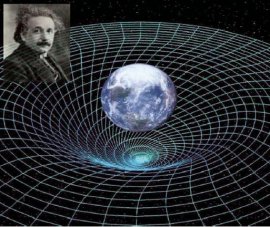
source: http://science.nasa.gov/science-news/science-at-nasa/2005/16nov_gpb/ :
a similar picture can be found on
http://news.stanford.edu/news/2005/may11/gpb-051105.html:
Since this page has been deleted lately (by end of 2022) - as so many pages concerning Einstein's Theory of Relativity, see the backup here: gpb-051105.html (since the whole world wants to see this page, be prepared to wait....)
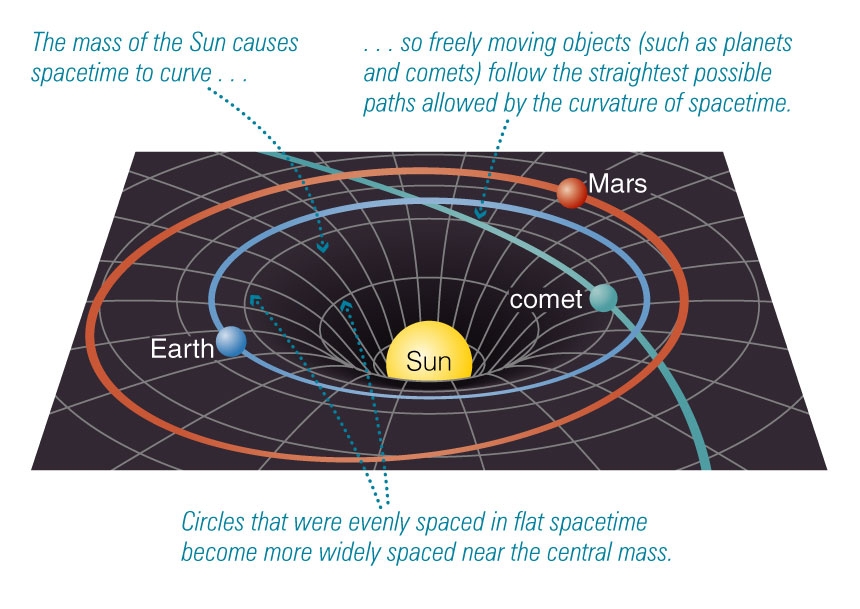
source: http://woodahl.physics.iupui.edu/Astro100/S3-13b_anno.jpg
Wrong assumption of Einstein and of all his advocates: Planets do not rotate around the central body of a solar/star system, instead they rotate around the barycenter of the system. Quite naturally, this disproves the Theory of Relativity completely, comprehensively and in whole and all of the derived theories, such as Black Holes, Gravitational Waves etc etc.
This seems now to be accepted world wide. So many videos as this one have disappeared lately completely.
The new idea and claim of this site is that solar systems do not rotate around the central body of a solar/star system, instead they rotate around the barycenter of the system. This claim was first proven by mathematical proof in 1969 and thereafter by computer simulations and in the sequel of the discovery of the exoplanet systems by the detection of more than 5000 exoplanets from 1995 to 2022. Finally in 2021 this theory was confirmed by a scientific study: "Most recently, the researchers took a closer look at the orbital motion of the sun. The Sun is not fixed at the center of the solar system: It performs a kind of dance in the common gravitational field with the massive planets Jupiter and Saturn - at a rate of 19.86 years".
The new idea and mathematical proof that solar/star systems rotate around the barycenter of a star system (and not around the star itself) was the initial idea and starting point that led to the discovery of the Exoplanet systems. An article in 'Sterne und Weltraum' 5/88 p.324 ( a magazine available in all astronomy libraries of the world, famous through Hans Elsässer, the original founder of the MPIA) in which the wobbling of our sun was described, made this theory known to the whole world in 1988. Only the theoretical knowledge that stars as well as planets rotate around the barycenter of star systems was the reason that already seven years later the first exoplanet was found. This in contrast to the fact that astronomers have searched in vain the sky for centuries to find any other planetary system. As many others, Geoffrey Marcy in the USA and the team Mayor and Queloz from Switzerland had read the article at the same time and had started the race of finding the first exoplanet also at the same time, but Mayor and Queloz proved to be faster in the end. There must have been other competing teams too, but of these two it is known that they opened up a veritable competition. Two teams which started at exactly the same time at different places of the earth the same search. Magic? And if this isn't enough, the theory behind the search of both contradicts the present governing theory. Still not enough magical mystery ? Read these two articles from an US-perspective: "The Remarkable Race to Find the First Exoplanet, And the Nobel Prize It Produced" and "A Telling Nobel Exoplanet Faux Pas". Not very enlightening, but treacherous. The first exoplanet was found by observing the wobbling of the central star in 51 Pegasi . And Geoffrey Marcy was honorable enough to confirm the finding. Many of those who followed later had not the publicity. Till today thousands of exoplanet systems were found since the first was found in 1995 with a very old fashion small telescope of 1958 by Doppler-Shift-Measurements. Thousands of newly found exoplanet systems prove that exoplanet systems rotate around the barycenter and not around the central star ( or stars). Thousands of astronomers are trying each day to find new Exoplanet systems by searching for wobbling stars.
1997 the NY Times published this article:
click on picture or follow this link to read the NY-Times-article from 1997.
To state this clearly: The discovery of the
exoplanets - without any question the greatest discovery ever in physics
(a german Professor called it 'the holy grail of physics') - took place
against the strongest resistance in all of physics. For years I did send
papers to scientific journals in vain, they all were rejected because
I could not conceal that Einstein's theory of relativity would be
refuted by the fact that stars wobble around the barycenter of a star
system. Accordingly, the Nobel Prize for the discovery of
exoplanets was not awarded for the theoretical discovery, but for the
craftmanship,
the manual discovery,
the purely practical discovery of the theoretically elaborated
wobbling of the stars
with a 1.93m telescope from
1958 and
a technique
which was used already 100 years earlier.
The trophy is not awarded to the athlete who wins the 100m race, but to
the timekeeper who stops the race. It is not the ski jumper who jumps
the longest distance who is crowned the winner, but the judge who
measures the distance with a tape measure. Not the javelin thrower who
throws the javelin the furthest, but the referee who measures the distance
receives the olympic gold medal.
It's not the winning soccer team that wins the Em Title and the cup, but
the arbitrator who blows the whistle receives the trophy. And the audience applauds.
It is not the architect who designed the house, but the carpenter, the
bricklayer who built the house who receives the architect's fee. It is
not the engineer who designed the car, the airplane, but the technician
who built the car, the airplane and thus proved that it works, who
receives the reward and the praise. The world is upside down.
What does this mean?
The curvature of the space-time continuum by the mass of the central body was the initial and central idea of Einstein's theory around which everything else was build: the General Relativity Theory (GRT). Stanford.edu: "According to Einstein's 1916 general theory of relativity—our present theory of gravitation—space and time are inextricably woven into a four-dimensional fabric called spacetime, and gravity is nothing but the warping and twisting of spacetime by massive celestial bodies." Now if this central idea is proven wrong, the whole theory is proven wrong.
The wobbling of the central star in the case of our solar system is not so obvious and only detectable by close scrutiny - the reason why it was detected so late. But since physics is an exact science this error in todays description of our solar system can't be tolerated or neglected and so this close scrutiny finally led to the discovery of the exoplanets. Mayor and Queloz who read the article in 'Sterne und Weltraum' 5/88 p.324 in which the wobbling of our sun was described, used Doppler-Shift-Measurements to detect the approaching and moving away of the central body in 51 Pegasi (Nobel prize 2019). Since this happened again and again, it was finally clear, there must be a planet rotating around the star - exactly as described in the article in 'Sterne und Weltraum' - which lets the star wobble and dance. And while in the case of our solar system the error in Einstein's theory isn't so big, in the case of some of the new found exoplanet systems ('hot' jupiters of 13 and more jupiter masses in direct neighborhood of their host star) this amounts to really big errors and demonstrates clearly to everyone that Einstein's theory is completely wrong.
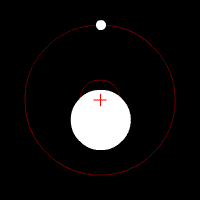
'Hot' Jupiter in nearby orbit to his star: does he orbits in the curvature
of space-time produced by the mass of the star? And why then does the star do wobble?
Really complicated the picture gets when there are several planets rotating around the central star (in reality rotating around the barycenter of the star system). Then the central star starts a dance, it wobbles around the barycenter of the star system.
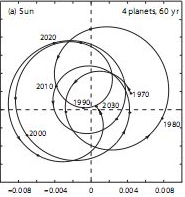
Wobbling of our sun around the barycenter of our solar system, as any precise computer simulation demonstrates (http://arxiv.org/abs/1010.0966).
This dancing or 'wobbling' of the central star is today no more disputed or argued. It was first proven by mathematical proof in 1969 and thereafter by computer simulations and in the sequel of the discovery of the exoplanet systems by the detection of more than 5000 exoplanets from 1995 to 2022. Finally in 2021 this theory was confirmed by a scientific study: "Most recently, the researchers took a closer look at the orbital motion of the sun. The Sun is not fixed at the center of the solar system: It performs a kind of dance in the common gravitational field with the massive planets Jupiter and Saturn - at a rate of 19.86 years".
Since the mass of the star deforms space-time according to Einstein's theory of relativity, the deformation of space-time would dance or wobble with the star in space. Since this deformation of space-time in Einstein's view again determines the orbits of the planets, the orbits of all planets would be subjected to a total chaos, would run in serpentines around the central star. Of course, this has never been observed in space and would object all laws of physics. Since the problems related to this topic seem so hard to comprehend for physicists - I try to explain the problems associated to this topic since more than 50 years to physicists and you have to explain every minor detail, else they won't understand it - I will perhaps open an extra page for this subject.
Polemic answers as this one - produced right after I uploaded this English language translation of my pages - show only the huge impact of this site and the inability to argue in physical terms. Substantive argumentation is replaced by formal pseudo-arguments, the AIP does not dare to discuss the arguments put forward, because otherwise it would be too obvious that there are no scientifically valid counter-arguments. Is this the way the AIP uncovers the unexpected stories behind the physics we know?
And yes, "There are professional best practices, norms, and standards that scientists must adhere to in order to reach acceptable conclusions to other scientists.". But if these "best practices, norms and standards" since 50 years collectively refuse to recognize and publish new theories, I think everyone agrees, it is necessary to resort to other means. As perhaps the best example, the Exoplanets were only discovered because the editors of "Sterne und Weltraum" did not recognize the contradiction of the wobbling-stars-theory to Einstein's relativity theory. All other magazines collectively refused to publish the theory. For really controversial theories the 'standard' way doesn't seem to be a viable way. Just as only one example, Darwin too choose to publish his theory not in one of the many biological reviews of his time, but published it in a manuscript entitled "Natural Selection".
And I tell no big news if I tell that these "best practices, norms, and standards" have since long been perforated and replaced by "big money" best practices: as only one example, I mention only best equipped very expensive pseudo-scientific documentaries clogging up the world's commercial tv channels to the point that some of them are now dependent on this sort of filling material between their commercials for their survival... Anyone not naive can tell you their retroactive effect on science and many more such "best practices".
It has to be noted here that Hermann Carl Vogel already in 1889 used radial velocity measurements to detect binary star systems, such as Algol. The same technique which used Mayor and Queloz one hundred years later to win Nobel Prize of 2019. Vogel was the one to note that these stars "appeared to be orbiting around a hidden center of mass" (Vogel used the term "center of gravity") and thus enabled me to argue in 1969 that binary star systems always rotate around their common barycenter and that this also applies to star-planet systems, since these differ only gradually from binary star systems.
Herman Carl Vogel even produced in 1892 radial velocity data for 51 stars. So it is no big speculation that if Einstein's theory had not prevailed at the beginning of the 20th century, ironically, in further pursuit of Hermann Carl Vogel's spectroscopic discovery of binary star systems, Exoplanets would have been discovered next at the beginning of the 20th century! This would have meant that Exoplanets could have been discovered almost one century earlier! It would only have been necessary the theoretical conclusion that star-planet systems differ only gradually from binary star systems.
![]()
![]()
Since you can read so much nonsense in the web concerning solar
systems and
barycenters, in 2024 space.com published the definitive answer:
https://www.space.com/space-mysteries-does-the-sun-move-in-the-solar-system
"Patrick Antolin is a solar scientist at Northumbria University who specializes in phenomena that we observe in the solar atmosphere, and in particular, the solar corona, which is the most extended layer of the sun's atmosphere.
"even within the frame of the solar system, the sun is not exactly static because of the gravitational interaction with the other bodies in the system," Antolin told Space.com.
(...)
The net result of all this is that the planets of the solar system don't technically orbit their star. Instead, the sun and each planet orbit a point of mutual gravity called a "barycenter," the location of which is determined by the masses of the bodies in question."
Please note: It took space.com more than 20 years (actually more than 50 years!) to tell you the truth. Article is from January 2024! So after the whole world has read these pages, they have finally decided to publish the truth.
